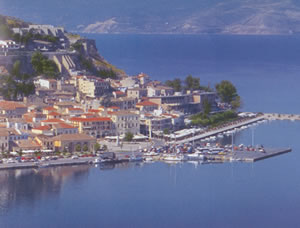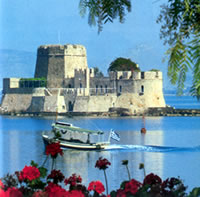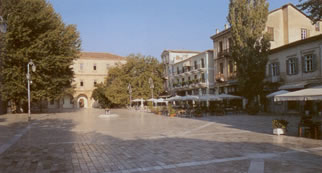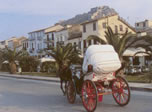
 This second name is a corruption of the Turkish name meaning 'Three Castles' and 'akronafplio'
means 'on the heights of Nafplio' (or, on the edge of the naval port). This fortress sits up over the south side of the
peninsula occupied by the city of Nafplio, over the little bay of Arvanita (said to be named for the bloody slaughter of
medieval Albanian (Arvanites) mercenaries by Hasan Pasha in 1779. The three castles were Greek, Frankish, and Venetian).
The first walls were built in ancient times of polygonal masonry and were used as a foundation for the successive
fortresses.
This second name is a corruption of the Turkish name meaning 'Three Castles' and 'akronafplio'
means 'on the heights of Nafplio' (or, on the edge of the naval port). This fortress sits up over the south side of the
peninsula occupied by the city of Nafplio, over the little bay of Arvanita (said to be named for the bloody slaughter of
medieval Albanian (Arvanites) mercenaries by Hasan Pasha in 1779. The three castles were Greek, Frankish, and Venetian).
The first walls were built in ancient times of polygonal masonry and were used as a foundation for the successive
fortresses.
On Bourtzi the islet of Aghio Theodhorou, 450 meters offshore stands the Castle Pasqualigo built in 1471 by the Venetians to protect the harbor entrance, and reinforced in the early 18th century. During the 19th century the public executioner of Nafplio lived there.

 The area near the main square in modern Nafplio, Platia Syndagmatos (left) (like Syndagma Square in Athens, the name comes
from the Greek word for 'Constitution') has been compared with the Plaka district in Athens (the old town) because of its
older architecture and attractive paving stones. There are three converted Ottoman mosques here, one of them used for a
cinema and theater on an irregular basis. Another was the first Greek parliament building, and the third has become
Aghios Yeorghios (after its previous incarnation as a Venetian church). There are two Turkish fountains here as well.
The Catholic church (converted from a mosque) has a monument to foreigners who died during the Greek War of Independence
(and includes Lord Byron).
The area near the main square in modern Nafplio, Platia Syndagmatos (left) (like Syndagma Square in Athens, the name comes
from the Greek word for 'Constitution') has been compared with the Plaka district in Athens (the old town) because of its
older architecture and attractive paving stones. There are three converted Ottoman mosques here, one of them used for a
cinema and theater on an irregular basis. Another was the first Greek parliament building, and the third has become
Aghios Yeorghios (after its previous incarnation as a Venetian church). There are two Turkish fountains here as well.
The Catholic church (converted from a mosque) has a monument to foreigners who died during the Greek War of Independence
(and includes Lord Byron).